PREREQUISITES
Let me start the question by providing some boilerplate code we'll use to play around:
mcve_framework.py:
from OpenGL.GL import *
from OpenGL.GLU import *
from OpenGL.GLUT import *
import glm
from glm import cross, normalize, unProject, vec2, vec3, vec4
# -------- Camera --------
class BaseCamera():
def __init__(
self,
eye=None, target=None, up=None,
fov=None, near=0.1, far=100000,
delta_zoom=10
):
self.eye = eye or glm.vec3(0, 0, 1)
self.target = target or glm.vec3(0, 0, 0)
self.up = up or glm.vec3(0, 1, 0)
self.original_up = glm.vec3(self.up)
self.fov = fov or glm.radians(45)
self.near = near
self.far = far
self.delta_zoom = delta_zoom
def update(self, aspect):
self.view = glm.lookAt(
self.eye, self.target, self.up
)
self.projection = glm.perspective(
self.fov, aspect, self.near, self.far
)
def move(self, dx, dy, dz, dt):
if dt == 0:
return
forward = normalize(self.target - self.eye) * dt
right = normalize(cross(forward, self.up)) * dt
up = self.up * dt
offset = right * dx
self.eye += offset
self.target += offset
offset = up * dy
self.eye += offset
self.target += offset
offset = forward * dz
self.eye += offset
self.target += offset
def zoom(self, *args):
x = args[2]
y = args[3]
v = glGetIntegerv(GL_VIEWPORT)
viewport = vec4(float(v[0]), float(v[1]), float(v[2]), float(v[3]))
height = viewport.w
pt_wnd = vec3(x, height - y, 1.0)
pt_world = unProject(pt_wnd, self.view, self.projection, viewport)
ray_cursor = glm.normalize(pt_world - self.eye)
delta = args[1] * self.delta_zoom
self.eye = self.eye + ray_cursor * delta
self.target = self.target + ray_cursor * delta
def load_projection(self):
width = glutGet(GLUT_WINDOW_WIDTH)
height = glutGet(GLUT_WINDOW_HEIGHT)
glMatrixMode(GL_PROJECTION)
glLoadIdentity()
gluPerspective(glm.degrees(self.fov), width / height, self.near, self.far)
def load_modelview(self):
e = self.eye
t = self.target
u = self.up
glMatrixMode(GL_MODELVIEW)
glLoadIdentity()
gluLookAt(e.x, e.y, e.z, t.x, t.y, t.z, u.x, u.y, u.z)
class GlutController():
FPS = 0
ORBIT = 1
PAN = 2
def __init__(self, camera, velocity=100, velocity_wheel=100):
self.velocity = velocity
self.velocity_wheel = velocity_wheel
self.camera = camera
def glut_mouse(self, button, state, x, y):
self.mouse_last_pos = vec2(x, y)
self.mouse_down_pos = vec2(x, y)
if button == GLUT_LEFT_BUTTON:
self.mode = self.FPS
elif button == GLUT_RIGHT_BUTTON:
self.mode = self.ORBIT
else:
self.mode = self.PAN
def glut_motion(self, x, y):
pos = vec2(x, y)
move = self.mouse_last_pos - pos
self.mouse_last_pos = pos
if self.mode == self.FPS:
self.camera.rotate_target(move * 0.005)
elif self.mode == self.ORBIT:
self.camera.rotate_around_origin(move * 0.005)
def glut_mouse_wheel(self, *args):
self.camera.zoom(*args)
def process_inputs(self, keys, dt):
dt *= 10 if keys[' '] else 1
amount = self.velocity * dt
if keys['w']:
self.camera.move(0, 0, 1, amount)
if keys['s']:
self.camera.move(0, 0, -1, amount)
if keys['d']:
self.camera.move(1, 0, 0, amount)
if keys['a']:
self.camera.move(-1, 0, 0, amount)
if keys['q']:
self.camera.move(0, -1, 0, amount)
if keys['e']:
self.camera.move(0, 1, 0, amount)
if keys['+']:
self.camera.fov += radians(amount)
if keys['-']:
self.camera.fov -= radians(amount)
# -------- Mcve --------
class BaseWindow:
def __init__(self, w, h, camera):
self.width = w
self.height = h
glutInit()
glutSetOption(GLUT_MULTISAMPLE, 16)
glutInitDisplayMode(GLUT_DOUBLE | GLUT_RGB | GLUT_DEPTH | GLUT_MULTISAMPLE)
glutInitWindowSize(w, h)
glutCreateWindow('OpenGL Window')
self.keys = {chr(i): False for i in range(256)}
self.startup()
glutReshapeFunc(self.reshape)
glutDisplayFunc(self.display)
glutMouseFunc(self.controller.glut_mouse)
glutMotionFunc(self.controller.glut_motion)
glutMouseWheelFunc(self.controller.glut_mouse_wheel)
glutKeyboardFunc(self.keyboard_func)
glutKeyboardUpFunc(self.keyboard_up_func)
glutIdleFunc(self.idle_func)
def keyboard_func(self, *args):
try:
key = args[0].decode("utf8")
if key == "\x1b":
glutLeaveMainLoop()
self.keys[key] = True
except Exception as e:
import traceback
traceback.print_exc()
def keyboard_up_func(self, *args):
try:
key = args[0].decode("utf8")
self.keys[key] = False
except Exception as e:
pass
def startup(self):
raise NotImplementedError
def display(self):
raise NotImplementedError
def run(self):
glutMainLoop()
def idle_func(self):
glutPostRedisplay()
def reshape(self, w, h):
glViewport(0, 0, w, h)
self.width = w
self.height = h
In case you want to use the above code you'll just need to install pyopengl and pygml. After that, you can just create your own BaseWindow subclass, override startup and render and you should have a very basic glut window with simple functionality such as camera rotation/zooming as well as some methods to render points/triangles/quads and indexed_triangles/indexed_quads.
WHAT'S DONE
mcve_camera_arcball.py
import time
from OpenGL.GL import *
from OpenGL.GLU import *
from OpenGL.GLUT import *
import glm
from mcve_framework import BaseCamera, BaseWindow, GlutController
def line(p0, p1, color=None):
c = color or glm.vec3(1, 1, 1)
glColor3f(c.x, c.y, c.z)
glVertex3f(p0.x, p0.y, p0.z)
glVertex3f(p1.x, p1.y, p1.z)
def grid(segment_count=10, spacing=1, yup=True):
size = segment_count * spacing
right = glm.vec3(1, 0, 0)
forward = glm.vec3(0, 0, 1) if yup else glm.vec3(0, 1, 0)
x_axis = right * size
z_axis = forward * size
i = -segment_count
glBegin(GL_LINES)
while i <= segment_count:
p0 = -x_axis + forward * i * spacing
p1 = x_axis + forward * i * spacing
line(p0, p1)
p0 = -z_axis + right * i * spacing
p1 = z_axis + right * i * spacing
line(p0, p1)
i += 1
glEnd()
def axis(size=1.0, yup=True):
right = glm.vec3(1, 0, 0)
forward = glm.vec3(0, 0, 1) if yup else glm.vec3(0, 1, 0)
x_axis = right * size
z_axis = forward * size
y_axis = glm.cross(forward, right) * size
glBegin(GL_LINES)
line(x_axis, glm.vec3(0, 0, 0), glm.vec3(1, 0, 0))
line(y_axis, glm.vec3(0, 0, 0), glm.vec3(0, 1, 0))
line(z_axis, glm.vec3(0, 0, 0), glm.vec3(0, 0, 1))
glEnd()
class Camera(BaseCamera):
def __init__(self, *args, **kwargs):
super().__init__(*args, **kwargs)
def rotate_target(self, delta):
right = glm.normalize(glm.cross(self.target - self.eye, self.up))
M = glm.mat4(1)
M = glm.translate(M, self.eye)
M = glm.rotate(M, delta.y, right)
M = glm.rotate(M, delta.x, self.up)
M = glm.translate(M, -self.eye)
self.target = glm.vec3(M * glm.vec4(self.target, 1.0))
def rotate_around_target(self, target, delta):
right = glm.normalize(glm.cross(self.target - self.eye, self.up))
amount = (right * delta.y + self.up * delta.x)
M = glm.mat4(1)
M = glm.rotate(M, amount.z, glm.vec3(0, 0, 1))
M = glm.rotate(M, amount.y, glm.vec3(0, 1, 0))
M = glm.rotate(M, amount.x, glm.vec3(1, 0, 0))
self.eye = glm.vec3(M * glm.vec4(self.eye, 1.0))
self.target = target
self.up = self.original_up
def rotate_around_origin(self, delta):
return self.rotate_around_target(glm.vec3(0), delta)
class McveCamera(BaseWindow):
def __init__(self, *args, **kwargs):
super().__init__(*args, **kwargs)
def startup(self):
glEnable(GL_DEPTH_TEST)
self.start_time = time.time()
self.camera = Camera(
eye=glm.vec3(200, 200, 200),
target=glm.vec3(0, 0, 0),
up=glm.vec3(0, 1, 0),
delta_zoom=30
)
self.model = glm.mat4(1)
self.controller = GlutController(self.camera)
glPolygonMode(GL_FRONT_AND_BACK, GL_LINE)
def display(self):
self.controller.process_inputs(self.keys, 0.005)
self.camera.update(self.width / self.height)
glClearColor(0.2, 0.3, 0.3, 1.0)
glClear(GL_COLOR_BUFFER_BIT | GL_DEPTH_BUFFER_BIT)
self.camera.load_projection()
self.camera.load_modelview()
glLineWidth(5)
axis(size=70, yup=True)
glLineWidth(1)
grid(segment_count=7, spacing=10, yup=True)
glMatrixMode(GL_PROJECTION)
glLoadIdentity()
glOrtho(-1, 1, -1, 1, -1, 1)
glMatrixMode(GL_MODELVIEW)
glLoadIdentity()
glutSwapBuffers()
if __name__ == '__main__':
window = McveCamera(800, 600, Camera())
window.run()
TODO
The end goal here is to figure out how to emulate the rotation used by 3dsmax when pressing Alt+MMB.
Right now with the current code you can move around using WASDQE keys (shift to accelerate), left/right button to rotate camera around it's/scene's center or zooming by using mouse wheel. As you can see, offset values are hardcoded, just adjust them to run smoothly in your box (I know there are proper methods to make the camera kinetics vectors to be cpu independent, that's not the point of my question)
REFERENCES
Let's try to disect a little bit more how the camera behaves when pressing alt+MMB on 3dsmax2018.
- Rottion at "home" (camera at home happens when you press the home button on the top right gizmo, that will place the camera position at a fixed location and target at (0,0,0)):

- Panning and rotation:

- Zooming/Panning and rotation:

- User interface

QUESTION: So next would be adding the necessary bits to implement arcball rotation when pressing alt+MMB... I say arcball rotation cos I assume 3ds max uses that method behind the curtains but I'm not really sure that's the method used by max so first I'd like to know what are the exact maths used by 3ds max when pressing alt+MMB and then just add the necessary code to the Camera class to achieve that task

